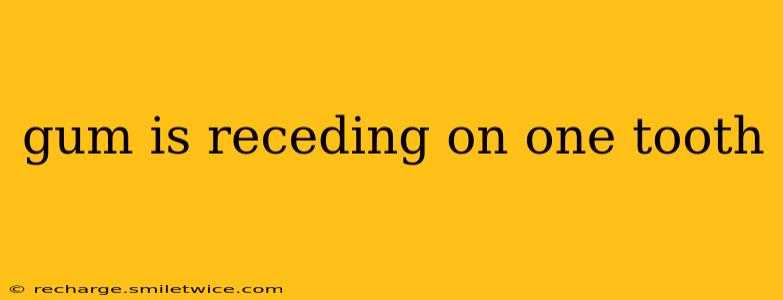Gum recession, the process where your gums pull back from your teeth, exposing more of the tooth root, is a common dental problem. While it can affect multiple teeth, it's also possible to experience gum recession on just one tooth. This can be unsettling, but understanding the causes, treatments, and preventative measures can help alleviate concerns and maintain oral health.
What Causes Gum Recession on One Tooth?
Several factors can contribute to gum recession, even if it only affects a single tooth. Identifying the cause is crucial for effective treatment.
-
Aggressive Brushing: Brushing too hard or using a hard-bristled toothbrush can damage gum tissue over time, leading to recession. This is particularly problematic if concentrated on one specific area.
-
Gum Disease (Periodontitis): This bacterial infection is a major cause of gum recession. Inflammation and infection destroy the tissues supporting your teeth, causing the gums to pull back. While it often affects multiple teeth, it can initially manifest on just one.
-
Genetics: Some individuals are genetically predisposed to gum recession, making them more susceptible even with excellent oral hygiene.
-
Misaligned Teeth (Malocclusion): Overlapping or crowded teeth can put extra pressure on the gums in certain areas, leading to recession. This is especially true if one tooth is significantly out of alignment.
-
Tooth Grinding (Bruxism): The excessive force from grinding or clenching teeth can damage gum tissue and contribute to recession, potentially focusing on one area.
-
Piercings: Oral piercings, especially those near the gum line, can irritate the gum tissue and contribute to recession in the affected area.
-
Certain Medical Conditions: Some medical conditions, such as diabetes and hormonal imbalances, can increase the risk of gum recession.
How is Gum Recession on One Tooth Treated?
Treatment for gum recession depends on the underlying cause and the severity of the recession. Here are some common approaches:
-
Improved Oral Hygiene: For mild recession caused by aggressive brushing, switching to a soft-bristled brush and a gentle brushing technique is essential.
-
Scaling and Root Planing: If gum disease is the cause, your dentist will perform a deep cleaning to remove plaque and tartar from below the gum line. This helps to control the infection and promote gum healing.
-
Gum Grafting: For more significant recession, gum grafting surgery might be necessary. This involves taking tissue from another area of your mouth (often the palate) and grafting it onto the affected area to cover the exposed tooth root. Different types of gum grafts exist, and your dentist will recommend the most suitable option based on your specific situation.
-
Guided Tissue Regeneration (GTR): This advanced technique uses a membrane to protect the area and encourage tissue regrowth.
-
Enamel Matrix Derivative (EMD): This gel contains proteins that promote natural tissue regeneration.
Does Gum Recession on One Tooth Go Away on Its Own?
Unfortunately, gum recession rarely reverses on its own. The damage to the gum tissue and supporting structures is often permanent without intervention. Early detection and treatment are crucial to prevent further recession and protect the tooth.
Can Gum Recession on One Tooth Be Prevented?
Preventing gum recession involves proactive measures:
-
Maintain Excellent Oral Hygiene: Brush gently twice a day with a soft-bristled toothbrush and floss daily.
-
Regular Dental Checkups: Visit your dentist for regular checkups and professional cleanings. Early detection of gum disease is key to preventing significant recession.
-
Avoid Aggressive Brushing: Use a gentle touch when brushing.
-
Address Bruxism: If you grind your teeth, consider using a mouthguard at night.
-
Manage Underlying Medical Conditions: Control conditions like diabetes that can increase the risk of gum disease.
What Happens if Gum Recession on One Tooth is Left Untreated?
Untreated gum recession can lead to several problems, including:
-
Tooth Sensitivity: Exposed tooth roots are more sensitive to temperature changes and sweets.
-
Tooth Decay: The exposed root is more susceptible to decay.
-
Loose Teeth: Severe recession can weaken the support structures holding your teeth in place, potentially leading to tooth loss.
-
Aesthetic Concerns: Receding gums can affect the appearance of your smile.
Addressing gum recession on one tooth promptly is vital for maintaining oral health and preventing more significant dental problems. Consult your dentist to determine the cause and receive appropriate treatment. Early intervention significantly improves the chances of successful management and preservation of your teeth.
